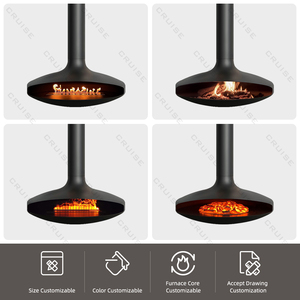
All categories
Featured selections
Trade Assurance
Buyer Central
Help Center
Get the app
Become a supplier

(6567 products available)






































There are several types of wood pellets that are suitable for fireplaces, with each type having unique characteristics. Fireplace insert pellets are among these types, and they have been specifically crafted to work well in pellet fireplaces. Quarry hardwood pellets are the most common type available and are mainly accused of producing a clean burn and minimal ash. Hence, they are good for the environment. Softwood pellets are denser than hardwood pellets and, as such, produce more heat. Premium-grade pellets ensure they meet stringent moisture and size standards. Experiencing different types allows one to evaluate and, therefore, determine the best-suited type of pellet for their needs, whether for heating, ease of handling, or other factors.
Wood pellets for fireplace usage have a design that contributes greatly to its burning efficiency and convenience. The pellets come in standardized diameters ranging from 6 mm to 8 mm. The reason behind such uniformity is practice since with uniform size comes uniform burn. The density of the pellets greatly impacts the energy content and the burn rate as well. Tighter compacted pellets tend to have higher energy content. A well-designed pellet will have low moisture content to minimize energy spent on vaporizing excess water rather than generating heat. The shape of pellets can sometimes vary depending on the producer, but the cylindrical shape is dominant due to ease of feeding into pellet stoves. Quality-grade pellets have heat-treated binding lignin instead of glue, and cheaper ones may have glue for binding them, which produces toxic smoke when burned.
When choosing the right pellet wood for the fireplace, several factors play a critical part in making the right selection. First and foremost, one needs to focus on the pellet material because different types of wood used to make the pellets will burn differently and generate different amounts of heat. Second, pellet size and shape are important because only pellets with the right size will efficiently feed into the pellet stove. Manuka pellets are for people looking for a distinct flavor in cooking or ambiance, while oak pellets provide high heat. Premium-grade pellets always carry certifications to signify their quality. One must also consider the moisture content within the pellet because higher moisture means lower heat, hence more efficient heating. Further, the compressibility and density of the pellets determine the amount of heat they can generate, where more compact pellets deliver greater heat output. Lastly, one should consider the availability of the quantity required and whether they can settle for a certain brand with consistent quality.
Pellet fuel fireplaces operate by automatically feeding pellets from a hopper into the combustion chamber. An auger, a screw-like device, moves the pellets from the hopper to the burn pot. A igniter or starter is used to light the pellets, usually an electric element. The combustion is then supported with air, which is blown into the burn pot by a fan. Both the amount of air and pellet feed can be adjusted to control the fire's size and heat output. Pellets are commonly used in detached houses where there is no space for a gas line to be installed. They are also preferred in regions where there are no natural sources of gas. Wood pellets are made from sawdust and wood byproducts compaction. They are renewable, though, since trees grow back, unlike fossil fuels. Fireplace wood pellets are sold in 15 kg bags for easy handling. Buying in bulk is easy and may be offered by some companies, hence reducing the overall cost per kg/bag.
The right maintenance and repair of wood pellet fireplaces are both crucial. The stoves, though, are much simpler than traditional chimneys, but they still require some attention to ensure efficiency and safety. One of the big ones involves cleaning the various components, including the burn pot, ash drawer, and heat exchanger, to remove ash and residue whenever left after burning. The hopper also needs to be cleaned to ensure no old pellets have accumulated and thus contaminate the new ones. One also needs to inspect the auger and remove any possible pellet jam. The seal checks on the doors or other parts must be examined, and worn ones changed to avoid heat loss. It can help assess whether parts have been worn out and need their replacement, such as blowers, ignitors, etc. Thus, the operating costs of pellet stoves are lower because little maintenance is done, but they still have slight care and repair costs to be incurred and time considered.
A1: Pellets made specifically for fireplaces are manufactured in various materials, mostly hardwood or softwood. They work using a pellet stove that automatically feeds the pellets from the hopper into the combustion chamber.
A2: The storage of pellet fuel for fireplaces requires dry places that aren't easily reached by water or wetness, keeping the pellets in a covered area or a plastic or tarpaulin sheet over them. The pellets also must be stored on the ground with a platform to prevent moisture absorption from the ground surface.
A3: Wood pellets are cost-effective, convenient, and easy to use in a fireplace. Pellets can provide consistent heat output and low emissions compared to other heating methods.
A4: Choosing the right pellets requires one to focus on pellets with low moisture content and high density. Ensure the pellets are made from pure, natural wood without a mixture of chemicals or added adhesives.
A5: The pellet fuel in the fireplace should be replenished as needed during operation, such as when the level in the hopper goes down. Most modern stoves have the capacity to hold several days' worth of pellets for heating.